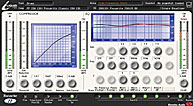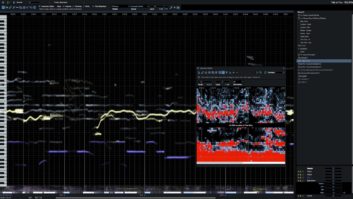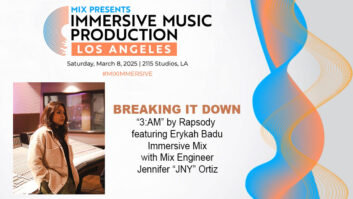
The same patented Dynamic Convolution™ emulation technology developed by Sintefex Ltd. for Focusrite’s popular Liquid Channel processor appears in Liquid Mix, an easy-to-use desktop DSP accessory for any DAW. Liquid Mix provides up to 32 plug-in (stereo versions count as two) emulations of equalization and compression processing chains at 44.1/48kHz sample rates from an included library of 40 compressors and 20 equalizers. Able to operate at rates up to 192 kHz, Liquid Mix’s EQs and compressors are fully controllable by either the on-screen GUI or hands-on control using the compact hardware remote.
The main panel features oscillators, filters, effects and output level controls.
Liquid Mix is powered and connected to the DAW computer’s FireWire 400 port, and a power supply is provided for FireWire ports without power rails. Because the DSP required for Dynamic Convolution is within Liquid Mix, there is almost no load on the host program’s CPU. The EQ/compressor emulations instantiate and appear as VST/Audio Units/RTAS plug-ins within the DAW.
Presently, Liquid Mix runs in Mac-based programs such as Steinberg Cubase and Nuendo, and MOTU Digital Performer. It also runs in Pro Tools TDM systems Version 6 and 7 with the proper FXpansion’s VST-to-RTAS wrap plug-in. By the time you read this, Focusrite plans to ship a Windows XP version, and the Universal Binary update for Intel-based Macs will be available online.
INSTALL/SETUP/USE
Liquid Mix comes with a DVD-ROM installer that includes the convolution files, Liquid Mix Manager application, a PDF manual and the VST-to-RTAS Adapter that, upon installation, “wraps” Liquid Mix for use in RTAS hosts.
Installing Liquid Mix files and applications in a Pro Tools HD3 Accel system running on a Quad-Core Power Mac G5 went smoothly, and the unit’s mono and stereo versions show up in the Wrapped Plug-Ins list. If you’re familiar with using VST wrapped plug-ins, then you’ll recognize some of the usual quirks, such as the common “focus” problem in which after typing a name in the plug-in GUI, you must click on any plug in Pro Tools’ GUI to regain focus and therefore control of Pro Tools. Focusrite is working on this wrapper integration issue, which is nonexistent in VST hosts.
The Liquid Mix Manager is a small application that must be running before you launch the host program. This application sets Liquid Mix’s operational parameters, beginning with the session sample rate and the maximum number of Liquid Mix instances. The max number possible over the 400Mb/sec FireWire bus at 44.1/48 kHz is 32 instances; selecting fewer instances reduces FireWire bandwidth usage. The app selects clip level at 0 dBfs. Liquid Mix can work with programs that use floating-point arithmetic to handle levels greater than 0 dBfs, such as Apple Logic; for Pro Tools, set the clip level at 0 dBfs. Start Minimized adds a handy Liquid Mix Manager icon to the Mac’s dock. Finally, Liquid Mix Manager tells you whether the Liquid Mix DSP expansion card is installed.

The expansion card goes inside the controller unit and doubles the maximum channel count only at higher sample rates. At 88.2/96 kHz, eight channels are normally available, whereas the card gives you 16 channels. At 176.4/192 kHz, two channels are possible, and with the card installed, this doubles to four channels.
DON’T BE LATE!
Due to FireWire’s bandwidth, operating Liquid Mix while other FireWire devices are connected can be problematic. This requires workarounds, such as transferring audio from the FireWire drive to a second internal hard drive or installing a second PCI FireWire card.
Because of the DSP-intensive convolution process — and the bidirectional trip over the FireWire bus — there is an inherent latency of 2,056 samples (measured in Pro Tools) including the wrapper layer. VST hosts and Pro Tools’ Delay Compensation automatically take care of this delay. This latency precludes the use of Liquid Mix for live applications. Also, using two instances of Liquid Mix on a single track (2,056×2) will exceed the allowed maximum of 4,095 samples in Pro Tools’ Long Delay Compensation engine. If you use Pro Tools LE, which does not include delay compensation, then you will have to manually delay all other audio and MIDI tracks by 2,056 samples.
SIMPLE CONTROLS
Using and navigating Liquid Mix within the DAW is just like working with any other plug-in: Click on its slot in the Pro Tools interface, and it opens. It’s good practice to type in a name in the Track window on the screen GUI after instantiation so that it shows up in the similar-looking controller front panel. Changes made on either the controller or in the GUI show up in both places.
If you don’t name plug-in instances, Liquid Mix automatically names them, beginning with the default “Plug-In Number 01” and increment to 02, 03 and so on. This is fine when starting a session by instantiating Liquid Mix instances beginning at track 1 and proceeding to 32. It’s a good idea to use Liquid Mix and this auto-naming feature as part of your 32-track session template.
EQ AND COMPRESSORS
The screen GUI provides access to all EQ sections with separate gain, frequency and Q controls, whereas the hardware controller requires that you scroll through a list of all the Liquid Mix instances that you’ve created, select one by its given name or default number, and then select the single EQ section you want to adjust.
However, the controller’s compressor controls — input, threshold, ratio, attack, release and gain makeup controls, along with the input level and gain reduction meters — mirror the GUI. The gain reduction meter has an expanded scale in 0.5dB increments up to -3 dB for dialing in exact compressor settings in the most critical range. The controller’s single data-entry knob and a set of buttons select emulations, EQ bands, shape or Q, parameter values, the current track, EQ and compressor I/O, compressor post-EQ (the default setting is pre-EQ), plug-in bypass, load/save snapshots, stereo link on/off and the yet-to-be-implemented sidechain monitoring. I liked the controller’s Go Back/Compare button to revert to saved settings or to the emulation’s initial settings.
The controller’s small, lighted LCD shows the compressor’s I/O transfer function graph; EQ names, sections, curves and frequencies; and the list of EQ and compressor emulations available.
LOADS OF PLUGS
Liquid Mix comes with emulations of many modern and “stars of yesteryear” processors, and more are available as downloads. I enjoyed trying out legendary units that I’ve never used. Emulations run from the “Viking 1/Danish Classic Tube 1,” an emulation based on Tube-Tech’s CL 1B compressor, to “Stellar 1 and 2,” emulations based on black-faced Rev D and a newer silver-faced Rev H UREI 1176LN peak limiters. Other emulations are based on processors from Manley Labs, BSS Audio, Drawmer, Amek, TL Audio, AMS Neve, Smart Research, Avalon, Teletronix, dbx, API, Empirical Labs, Joemeek, Millennia Media, Summit Audio, Solid State Logic, Pye, the rare Chiswick Reach and Fairchild 670, EAR, Chandler Limited, Pultec and even Focusrite.
I tried an emulation of a Pultec EQP-1 equalizer followed by a Fairchild 670 compressor on a lead vocal. This chain produced the perfect level of control and “vibe” that I was looking for. In general, I found that all of the emulations worked flawlessly and realistically represented the originals — warts and all! Warts? I discovered the amazing Free switch that unlocks controls and parameters not offered (or even thought of) in the original units. The Free switch is available on all compressor emulations.
On the Fairchild, the attack and ratio controls on the GUI are grayed out because the original unit never had them. Also, like the original, release time is offered as a choice of six different arcane time constants. With Free, I now had a Fairchild with variable ratio from 1:1 to 20:1, attack times from 0.1 ms to 2 seconds, and release times from 1 ms to 20 seconds. This is a fantastic feature because, operationally, vintage gear sometimes leaves a lot to be desired, although the sonic character is usually worth it. With Free, you have total and modern control over an old room heater like the Fairchild.
The quirky and smooth-sounding Pultec has only two frequency bands, both with simultaneous boost and cut controls. Within every Liquid Mix emulation, there are actually seven EQ bands available for realizing the original piece of gear. Using either the controller or the GUI, you can add EQ sections from any equalizer emulation into any other EQ to build your ultimate tone-shaper.
I added another midrange EQ band to the Pultec because I had already set its high-frequency range to 12 kHz. I added the HMF section of a Focusrite ISA 115 — perfect for adding a little cut at 2kHz broad — to the vocal. One quirk is that, unlike a lot of plug-ins, the GUI’s pull-down list of EQs retains no arrow at the currently chosen EQ.
MODERN DAW TOOL
Focusrite’s Liquid Mix stands tall in the ever-growing crowd of external DSP effects processors. It is unique, being the only system with a hardware control surface and a large collection of emulations based on coveted and vintage analog equalizers and compressors. Liquid Mix is a time portal — a modern DAW tool that connects today’s music-makers with the classic gear of a bygone era.
Prices: Liquid Mix, $799; expansion card, $249.
Focusrite, 866/FOCUSRITE, www.focusrite.com.
Barry Rudolph is an L.A.-based recording engineer. He can be contacted at
www.barryrudolph.com.







